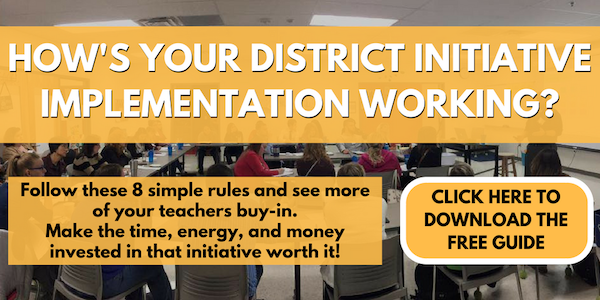TL;DR:
- Common concerns involving district initiative implementation include initiative fatigue, lack of time, failure to communicate, and lack of results.
- Supporting teaching and learning requires a thoughtful planning stage followed by a thorough implementation process.
- To find success with district initiative implementation, go slow to see long-term results.
One of the main barriers to student understanding and school transformation is the impulse of teachers and administrators to go fast. Americans expect fast food, Instagram, movies on-demand, and other tools or services which deliver a product or service within seconds. Today, educators have more options for supporting teaching and learning than ever before. If you survey the faculty at your school, you will hear concerns such as initiative fatigue, lack of time, failure to communicate, and lack of results. Supporting teaching and learning may require a thoughtful planning stage, followed by a thorough implementation process.
The following list highlights examples of schools going too fast during implementation:
- AVID
- Common Formative Assessments
- Curriculum Mapping
- Genius Hour
- 1:1 Technology Integration
- Professional Learning Communities
- Project-Based Learning
- Standards-Based Report Cards
- STEM
- Student-Led Conferences
Go Slow: Initiative Fatigue
“The Law of Initiative Fatigue states that when the number of initiatives increases while time, resources, and emotional energy are constant, then each new initiative—no matter how well conceived or well intentioned—will receive fewer minutes, dollars, and ounces of emotional energy than its predecessors” (Reeves, 2010).
When was the last time you stopped to analyze the number of school or district initiatives? If teachers are not implementing the program properly or do not have the time to practice, student understanding will be reduced. No school attempts to widen achievement gaps, but too many well-intended initiatives or programs can actually hurt the chances of supporting students.
Go Slow: Lack of Time
Teachers across the United States are making the transition from teaching and planning in isolation to operating as a professional learning community. Most teachers agree that this is a more efficient way to operate. In the beginning, buy-in is high. However, during the implementation phase, “there is a gap between the compass and the clock – between what’s deeply important to us and the way we spend our time” (Covey, Merrill & Merrill, 1994, p. 16).
If building principals do not change the schedule, then it is difficult for teachers to operate as a professional learning community. A lack of time cannot be corrected by teachers, since the principal is in charge of the master calendar. When teachers are required to implement formative assessments, design technology-rich unit plans, provide personalized learning, and implement a new standards-based report card, something has to give.
Go Slow: Failure to Communicate
One of the leading reasons education initiatives fail is due to a failure to communicate. Principals and associate superintendents are proficient at the announcement and the initial implementation. They may even develop a guiding coalition to support the change process.
Too often, teachers share that they don’t know the vision. They understand the need for change, but they feel like the communication plan never reached the classroom teachers. Communication needs to take place at the beginning, middle, and end of an initiative. Failure to communicate is like attempting to drive 75 mph in the dark without headlights. The teachers cannot see where they are going. Driving fast may help teachers and students cover the material or reach the final destination, but it does not guarantee results.
[scroll down to keep reading]
Go Slow: Lack of Results
Outside of the field of education, there is a focus on Return on Investment (ROI). In education, initiatives are rarely analyzed by teachers or administrators. Did the 1:1 technology integration support student understanding and other goals we established when we purchased the devices? Is the focus on STEM supporting teaching and learning or do teachers need additional professional development? Are the students in the middle school AVID program having success in high school classes?
When we go too fast, we fail to analyze whether our efforts are making a difference. The lack of results is often blamed on an initiative, so educators begin looking for the next initiative.
Conclusion
Educators feel the need to go fast. While we need a sense of urgency when it comes to supporting struggling readers and implementing programs to support student understanding, we need to remember to slow down and reflect.
When was the last time your staff met to reflect? Pump the breaks this nine weeks and reflect on your goals. Are you seeing a return on the investment? Waiting until high school graduation is too late to analyze your inputs and outputs. Slow down to go fast.
About Steven Weber
Dr. Steven Weber is the Associate Superintendent for Teaching and Learning with Fayetteville Public Schools (AR). His areas of research include curriculum design, formative assessment, professional learning, and school leadership.



